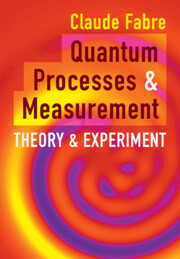Book contents
- Frontmatter
- Contents
- Introduction
- 1 Experiment: Detecting Single Quantum Objects
- 2 Description of Quantum Systems in Terms of the Density Matrix
- 3 Experiment: Quantum Processes
- 4 Evolution
- 5 Measurement
- 6 Experiment: Bipartite Systems
- 7 Entanglement
- 8 Experiment: Continuous Quantum Fluctuations
- 9 Continuous Variable Systems
- 10 Experiment: Parameter Estimation
- 11 Theory: Parameter Estimation
- A Basic Postulates of QuantumMechanics: a Reminder
- B Generalized Postulates of Quantum Mechanics
- C Description of Composite Systems
- D Qubits
- E Quantum Particle
- F Quantum Electromagnetic Field
- G Interaction between Light and Atoms
- H Interaction between Light Beams and Linear OpticalMedia
- I Interaction between Light Beams and Nonlinear OpticalMedia
- J Optomechanics
- K Basics of Circuit Quantum Electrodynamics
- References
- Index
J - Optomechanics
Published online by Cambridge University Press: 27 July 2023
- Frontmatter
- Contents
- Introduction
- 1 Experiment: Detecting Single Quantum Objects
- 2 Description of Quantum Systems in Terms of the Density Matrix
- 3 Experiment: Quantum Processes
- 4 Evolution
- 5 Measurement
- 6 Experiment: Bipartite Systems
- 7 Entanglement
- 8 Experiment: Continuous Quantum Fluctuations
- 9 Continuous Variable Systems
- 10 Experiment: Parameter Estimation
- 11 Theory: Parameter Estimation
- A Basic Postulates of QuantumMechanics: a Reminder
- B Generalized Postulates of Quantum Mechanics
- C Description of Composite Systems
- D Qubits
- E Quantum Particle
- F Quantum Electromagnetic Field
- G Interaction between Light and Atoms
- H Interaction between Light Beams and Linear OpticalMedia
- I Interaction between Light Beams and Nonlinear OpticalMedia
- J Optomechanics
- K Basics of Circuit Quantum Electrodynamics
- References
- Index
Summary
Appendix J: mechanical effects of light on matter. The appendix first derives the two forces exerted by a light beam on an atom: the radiation pressure force and the dipole force. Appropriate combinations of beams lead to a friction force that slows the atoms (Doppler cooling), and to a trapping force in the so-called magneto-optics trap (MOT). One then considers the forces exerted on ions, leading to trapping in a suitable geometry of electrodes and fields. Two configurations are used, named Paul and Penning traps. In addition, it is possible to cool the ions to their ground motional state using sideband cooling. It is also possible to trap and cool macroscopic nano-objects, such as microdiscs, membranes, toroids, etc. in a resonant optical cavity.
Keywords
- Type
- Chapter
- Information
- Quantum Processes and MeasurementTheory and Experiment, pp. 268 - 278Publisher: Cambridge University PressPrint publication year: 2023

